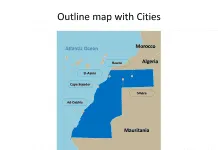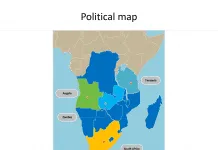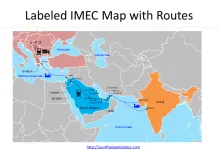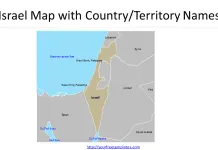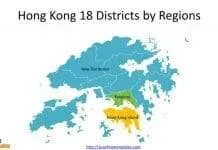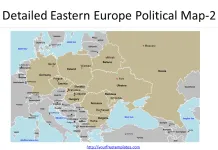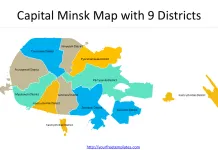The Mali Map Template includes two slides. Mali map with eight regions (régions) and one district, labeling with major regions, Sikasso, Koulikoro, Ségou, and Mopti. Mali map labeling with national capital and major cities, Bamako, Sikasso, Mopti, Ségou, and Gao.
Mali, a landlocked country in Western Africa, is bordered by Algeria, Burkina Faso, Guinea, Côte d’Ivoire, Mauritania, Niger, and Senegal. The country, mostly in the Saharan and Sahelian regions, has a population of approximately 23,948,000. The Bambara ethnic group and language predominate, with other groups such as the Fulani, Dogon, and Tuareg also present.
Mali’s economy heavily relies on agriculture, particularly cotton production, cattle and camel herding, and fishing. The country’s fiscal status is closely tied to gold mining and agricultural exports. Mali’s economic activity is concentrated in the riverine area irrigated by the Niger River, with about 80% of the labor force engaged in farming and fishing. The country faces challenges such as high population growth, corruption, weak infrastructure, and low levels of human capital, which continue to constrain its economic development.
Slide 1, Mali map labeled with capital and major cities.
Its capital and largest city is Bamako, other major cities including Sikasso, Mopti, Ségou, and Gao.
Capital and Major Cities on Mali map
Bamako
Bamako, the capital and largest city of Mali, is a bustling metropolis situated on the Niger River. With a population exceeding 2 million, it serves as the country’s political, economic, and cultural center. Bamako is renowned for its vibrant markets, cultural heritage, and the National Museum of Mali, and it plays a pivotal role in shaping the country’s urban landscape and economic activity.

Sikasso
Sikasso, the second-largest city in Mali, is located in the Sikasso Region and has a population of approximately 225,753. It is an essential center for agriculture and trade, known for its fertile soils and the production of cotton, mangoes, and tobacco.
Mopti
Mopti, situated in the Mopti Region, is a significant city with a population of around 114,296. Positioned at the confluence of the Niger and Bani rivers, it serves as a vital hub for fishing, agriculture, and transportation, earning it the nickname “Venice of Mali.”
Ségou
Ségou, with a population of approximately 150,000, is located in the Ségou Region. It is recognized for its rich history, arts, and traditional craftsmanship, making it a cultural and economic focal point in Mali.
Gao
Gao, situated in the Gao Region, is a historic city with a population of around 87,000. As one of the oldest settlements in West Africa, it holds significant cultural and economic importance, particularly as a center for trans-Saharan trade.
Slide 2, Mali map labeled with major administration districts.
Mali map shows the country divided into eight regions (régions) and one district; they are Bamako, Gao, Kayes, Kidal, Koulikoro, Mopti, Ségou, Sikasso, and Tombouctou. The most populated regions are Koulikoro, Mopti, Ségou, and Sikasso. Every individual political subdivision is an editable shape.
Major Regions on Mali map
Sikasso Region
The Sikasso Region, located in the south of Mali, is known for its agricultural productivity and diverse cultural heritage. It is a key area for cotton, fruit, and vegetable production, contributing significantly to the country’s agricultural output.

Koulikoro Region
The Koulikoro Region, home to the capital city, Bamako, is a vital economic and administrative center. It encompasses key urban and rural areas, playing a pivotal role in Mali’s political and economic landscape.
Ségou Region
The Ségou Region, with its cultural and historical significance, is a major center for traditional craftsmanship and arts. It is also known for its agricultural productivity, particularly in rice cultivation.
Mopti Region
The Mopti Region, with Mopti as a major city, is situated at the crossroads of Mali’s diverse ethnic groups and is a crucial hub for fishing, agriculture, and trade, shaping the region’s economic and cultural dynamics.
In summary, Mali’s capital, major cities, and regions contribute uniquely to the country’s cultural heritage, economic activity, and regional development. From the vibrant urban center of Bamako to the historical allure of Ségou and Gao, each location plays a distinctive role in shaping Mali’s diverse urban and rural landscape.
Looking for Premium maps, please visit our affiliate site: https://editablemaps.com/ or https://ofomaps.com/
Size: 97K
Type: PPTX
Aspect Ratio: Standard 4:3
Click the blue button to download it.
Download the 4:3 Template
Aspect Ratio: Widescreen 16:9
Click the green button to download it.
Download the 16:9 Template

